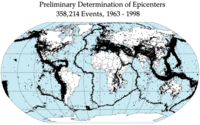
Photo from wikipedia
Southwest Turkey, along Mediterranean coast, is prone to large earthquakes resulting from subduction of the African plate under the Eurasian plate and shallow crustal faults. Maximum observed magnitude of subduction… Click to show full abstract
Southwest Turkey, along Mediterranean coast, is prone to large earthquakes resulting from subduction of the African plate under the Eurasian plate and shallow crustal faults. Maximum observed magnitude of subduction earthquakes is Mw = 6.5 whereas that of crustal earthquakes is Mw = 6.6. Crustal earthquakes are sourced from faults which are related with Isparta Angle and Cyprus Arc tectonic structures. The primary goal of this study is to assess seismic hazard for Antalya area (SW Turkey) using a probabilistic approach. A new earthquake catalog for Antalya area, with unified moment magnitude scale, was prepared in the scope of the study. Seismicity of the area has been evaluated by the Gutenberg-Richter recurrence relationship. For hazard computation, CRISIS2007 software was used following the standard Cornell-McGuire methodology. Attenuation model developed by Youngs et al. Seismol Res Lett 68(1):58–73, (1997) was used for deep subduction earthquakes and Chiou and Youngs Earthq Spectra 24(1):173–215, (2008) model was used for shallow crustal earthquakes. A seismic hazard map was developed for peak ground acceleration and for rock ground with a hazard level of a 10% probability of exceedance in 50 years. Results of the study show that peak ground acceleration values on bedrock change between 0.215 and 0.23 g in the center of Antalya.
Journal Title: Journal of Seismology
Year Published: 2017
Link to full text (if available)
Share on Social Media: Sign Up to like & get
recommendations!